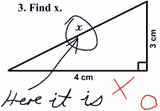The Riemann Hypothesis
Some Starting Definitions
We need a few simple definitions before we talk about this hypothesis.
- A complex number: is just a special type of number that has not only a real part, but also an imaginary part (a multiple √-1).
- The zeros of the Zeta Function: are complex numbers that, when plugged into the Riemann Zeta Function, evaluate it to zero.
So, now that we know these terms, we can explain what the Riemann Hypothesis is.
The Riemann Hypothesis
Thus far, all the discovered zeros of the Zeta Function have a real part equal to ½. Is this just a coincidence, or is there a pattern here? The Riemann hypothesis guesses that it is a pattern, and that every single one of these zeros has the same real part of ½.
Progress!
So far, we are in good shape; the first 1,500,000,000 zeros all fit the pattern. Unfortunately, this can’t be considered a proof. If the next zero was an exception to the rule, the Riemann Hypothesis would be false.
So, mathematicians are still looking for a way to prove this hypothesis, not only for the million dollar prize, but because it is considered one of the most important unsolved problems in the field of mathematics.
Primed and Ready
I can tell that at this point you are wondering: so what? Why is this problem so important to warrent so much attention? It all has to do with the prime numbers.
Primes are the building blocks of the number system. Every other whole number can be made by multiplying primes together. Mathematicians today are always on the hunt to find more of them.
Unpredictibility
Unfortunately, we have no simple way to find primes or predict when they will pop up. Even when we find a prime number, we still have to check to see if it's actually prime. One way to check primality is to try and divide the prime candidate by all the numbers smaller than it. That’s not very efficient or easy, especially when your prime numbers get very large. Think of how many divisors you would have to check! Although there are much faster methods to check a prime, going through every single candidate is time consuming.
A New Function
Now consider for a moment, a function that takes a number x and returns how many primes are beneath it. For example, if x was 8, the function would return 4, because 7, 5, 3, and 2 are all the primes less than 8. Since some values of x return the same number (9 also has 4 primes below it), a graph of this function looks like the steps of a staircase. This is why our function is referred to as a step function.
The Prime Staircase
It turns out that this step function is very close to being x/ln(x). Since x/ln(x) is smooth and our step function is not, this approximation is not exact, but it’s close. If we could improve this function somehow, we would have a better probabilistic model of when the primes would appear.
The Riemann Connection
This is where the Riemann Hypothesis comes into the picture. Suppose we look at the smooth x/ln(x) graph, and we start adding frequencies to it that are the zeros of the Riemann Zeta Function. The function we are constructing gets closer and closer to the step function of the primes we were considering.
So, if we could find all the zeros of the Riemann Zeta Function, we could make a function that tells us the underlying distribution of the primes.
A New Found Order
All of a sudden, the number system is not so unpredictable. The primes still appear at random, but with an underlying probability, much like the probability of a flipped coin. There is no way to know whether you will get heads on the next flip, but over a lot of flips, we know that heads would occur about half of the time. The primes would be very much the same. This would be an amazing advance for mathematics. All we need is to know for sure that the Riemann Hypothesis is true.





